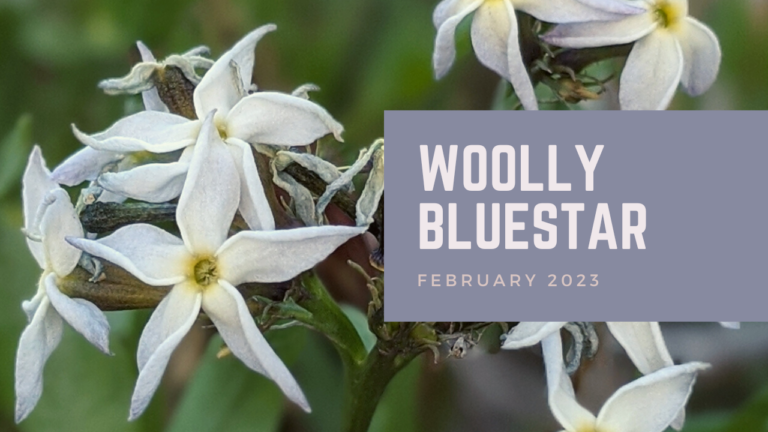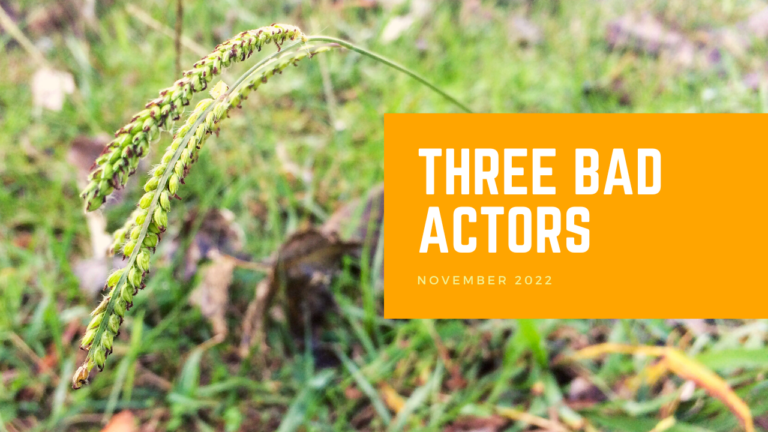Presented by Tom Linton
October 11, 2021
Botanical name: Dermatophyllum secundiflorum
Common names: Texas Mountain Laurel, Mountain Laurel, Mescal Bean, Frijolillo, Frijolito
Family: Fabaceae (Pea)
[MUSIC—EASY AND FUN]
[Tom] This started off as a challenge to me. We had a Mountain Laurel plant, which is a beautiful thing.
What got me started was trying to get this thing to bloom. We had it. It makes a lovely tree for landscaping and eventually it will bloom. You see on the left in this slide, these violet-colored things. But in looking at trying to get some more plants for the yard, I found that it took, in reading from A&M Extension work, which is my source of information, it takes five to ten years for the seed to germinate if allowed to just drop undisturbed on the ground.
I have, and somewhere Debbie has this fixed for you, a fact sheet. There’s about six pages of information here about the thing, but in a five-minute presentation I don’t have time to tell you all of the things that you usually get in a plant of the month. But it tells you their scientific name. It also tells you that just recently this and three other plants have been combined into a new genus for that plant.
It is a plant that would appeal to very many of you because those of you who bought plants at the plant sale and still haven’t gotten them out of your car or haven’t planted them. You’re a person with patience and so this thing is not only one for the patient but the kind of lazy person such as I am.
It likes both heat and drought tolerant. And, so, simply by placing it out in areas that you do not tend very much, it will thrive and do well. It does not respond well to pruning. Fortunately, I never pruned our tree very much. And, so, I did only cut it back very slightly in the spring just before it started to bloom.
And on the left is a picture of the tree in our front yard, and in the middle are some seed pods on our tree in the front yard, and on the right is a picture of seed pods from the web to show you what they look like when they’re ready to be taken out.
The seeds, like many plants do in desert, or many, conditions, when they get to the stage that they are on the right. They will pop open, and the two halves of the seed pod will twist and sling the seeds from one side to the other.
But if you see, look closely, they have a coating on them. It’s almost like fiberglass and so that’s why it takes so long for them to germinate in nature.
I started this about three years ago, trying to get some more plants for the yard, and first year I put the seed in and it took forever for them to come up, and I didn’t get much growth. Then I started researching this and I find that if you…
This is a container that’s left over from my apple turnovers that I got at HEB. So, I took some potting soil and put it in a container and dampened it, and then put six seeds, as you can see. And I kept watching those and watching those and they didn’t make it through the year.
And so what I finally did was more research on A&M Extension about plants. Found that if you scar them… And so I soaked them in water, some for 24 hours some for 48 hours, and then I took a three-sided file, a rat tail file, and when they were softened a bit, the outer coating, and made a little scar in each one on them.
And maybe if all goes well, they come up and they look like this and they grow very slowly. It takes a lot of patience to get them to do this. And so those of you who were at the plant sale, I donated 10 or 15 plants that I got up to a reasonable size, maybe you saw them and maybe some of you bought them.
I have now started collecting seeds and I have a fairly good collection of seeds.
This is a bush in full bloom. When they’re blooming like that… The first time this bloomed in our yard, I walked out one morning and it smelled like grape Kool-Aid. And there were bees and butterflies and all kind of things around on it on those blossoms. The blossoms look like a cluster of the white grapes you buy in the store. And they just cover the tree.
And you see here this is planted in a sloping roadside area. You can see it’s pretty rocky. So, the point being, it can withstand very dry conditions therefore for xeriscaping is a wonderful plant for that. It doesn’t take much care and attention, and being kind of a lazy gardener that I am, I like that attribute.
But this is what you strive for.
Oh, one other thing, the fact sheet. Debbie has posted that on the web, so if anybody wants amazing amount of information about this plant, you can find that on the website, and read at your leisure about what its name is, where it came from, and where it grows.
And last, but not least, it grows in courtyards and it loves poor soil with low maintenance.
So, questions please.
[Venita] How long did it take to get from the seed to that tiny little plant you showed us?
[Tom] It took me most of the summer.
[Venita] Okay.
[Tom] It’s about two months. That was when I finally got the hang of it. But the first couple of years I zeroed on that one. But once you soak them you can feel the outer coating getting a little soft and then you take something you know a nail file or pocketknife, just scratch it a little bit put it back in the water overnight then put it in a wet potting soil or damp potting soil and that last thing that we saw is what you get.
[Venita] Okay, so you said soak for 24 hours, scar it, soak for 24 hours, wet potting soil.
[Tom] Yeah.
[Venita] Okay, thank you.
[Tom] And in the information I got, it said that the seeds in nature, when they are allowed to just do the natural thing when they pop out, fly away, it takes from five to ten years for them to germinate out in the desert conditions so I was trying to speed that process up. And so far I’ve been able to do that. Thank you very much.
[MUSIC—AND THAT’S IT]
Resources
Related Posts

Plant of the Month: Woolly Bluestar
Our Plant of the Month for February 2023 is Amsonia tomentosa, commonly known as Woolly Bluestar, Woolly Amsonia, Small Leaved Amsonia, or Gray Amsonia.

Plant of the Month: Oyster Mushroom
Our plant of the month for January isn’t a plant at all, it’s a fungus!
Botanical name: Pleurotus ostreatus
Common name(s): Oyster Mushroom, Pearl Oyster Mushroom

Spotlight on Invasives: Three Bad Actors
Spotlight on Invasives: Johnsongrass (Sorghum halepense), Southern Crabgrass (Digitaria ciliaris), and Dallisgrass (Paspalum dilatatum)

